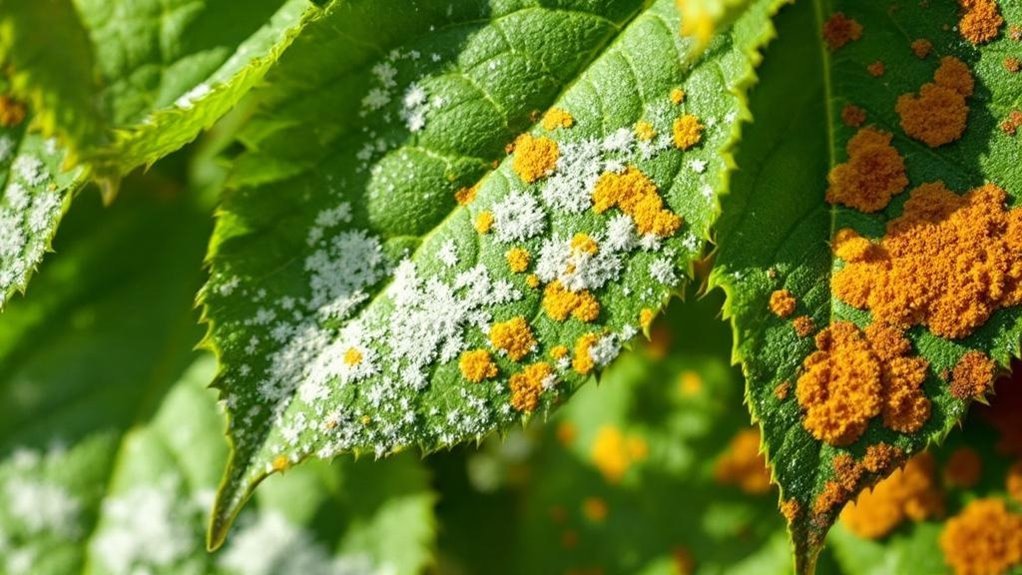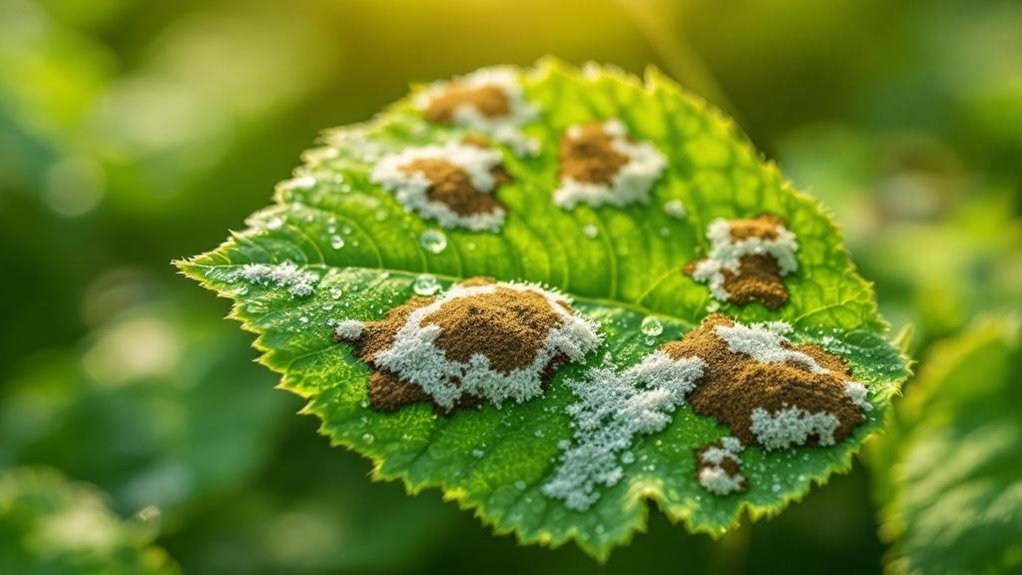Spotting fungal diseases in your plants is like finding a hidden message in the leaves—each symptom tells a story if you know how to interpret it. You might notice strange spots, unusual molds, or wilting that doesn’t respond to water. But how do you tell these signs apart from other problems, and what tools can help you pinpoint the issue accurately? Understanding these clues is key to protecting your plants before it’s too late.
Common Signs of Fungal Diseases on Plants
When you spot powdery mildew or leaf rust on your plants, you’re likely dealing with a fungal infection. These fungal diseases often produce visible symptoms like leaf spots, blight, and chlorosis, which are key symptoms of plant disease to watch for.
Plant pathogenic fungi create distinct signs such as concentric rings in leaf spots or fuzzy mold on decayed tissue, helping you identify the problem. Environmental conditions, especially high humidity and mild temperatures, encourage the development and spread of these infections.
Identifying Leaf Spots and Lesions
Spotting leaf spots and lesions can help you pinpoint fungal infections early. Leaf spots are common symptoms of fungal diseases, showing as dark, sunken lesions with varied colors and shapes. You might see target-like spots with concentric rings, typical of pathogens like Septoria or Alternaria. Necrotic lesions can cause leaf drop and signal plant pathogens at work. Sometimes, visible fruiting bodies or mycelium appear on leaves, confirming fungal presence. Effective diagnosis relies on observing lesion patterns to identify the specific fungal disease affecting your plants.
| Symptom Type | Description |
|---|---|
| Target-like spots | Concentric rings, often dark |
| Necrotic lesions | Dead tissue causing leaf drop |
| Fruiting bodies | Visible fungal structures |
| Sunken lesions | Dark, depressed areas on leaves |
| Bird-eye spots | Circular spots, common in anthracnose |
Recognizing Powdery Mildew and Rusts

Although both powdery mildew and rusts affect plants differently, recognizing their distinct symptoms is key to managing these common fungal diseases.
You’ll notice powdery mildew as white, powdery fungal growth on leaves, stems, and buds, especially when plants are crowded or in warm, dry conditions with high humidity.
Rust diseases, on the other hand, show rust-orange pustules mainly on leaf undersides, thriving in cool, moist weather with prolonged leaf wetness.
Both diseases stress plants, reducing photosynthesis and harming plant health if you don’t act quickly. Early detection helps you apply treatments like fungicides effectively.
Proper plant spacing and watering practices also limit fungal growth, making it easier to keep your plants healthy and disease-free.
Understanding Blights and Cankers
Because blights and cankers cause significant damage to plants, understanding their symptoms and management is crucial for maintaining plant health.
Recognizing and managing blights and cankers is essential to protect and sustain healthy plants.
Blights, caused by fungal pathogens like Alternaria, rapidly wilt and brown plant tissues, while cankers form sunken, dead areas on stems or branches.
You can spot these symptoms by looking for:
- Water-soaked spots that turn into dark lesions (blights)
- Sunken, discolored patches with clear margins (cankers)
- Rapid spread of spores via wind and water (blights)
- Transmission through infected tools or debris (cankers)
For effective disease management, remove infected material, improve air circulation, and apply fungicides as needed.
Staying vigilant helps you control these fungal threats and keep your plants healthy.
Differentiating Fungal Symptoms From Other Pathogens

When you examine your plants closely, you’ll notice fungal diseases often cause dry, papery leaf spots or target-like lesions with concentric rings, unlike bacterial infections that create dark, wet areas with angular edges.
Viral diseases, on the other hand, produce green spots without visible fungal signs like mycelium or sporulation. To differentiate fungal symptoms from other pathogens, observe the specific disease symptoms on each plant species.
Fungal infections often show powdery mildew or leaf rust, while bacterial pathogens may cause soft rot in fleshy plants. Viruses usually don’t produce visible signs and can’t be pruned out.
Regularly inspecting these signs and symptoms helps you identify whether fungal diseases are the culprit, allowing you to take proper action to protect your plants effectively.
Environmental Conditions Favoring Fungal Growth
Understanding how to spot fungal symptoms is a great start, but knowing the conditions that help fungi thrive will improve your ability to prevent infections.
Fungal growth depends heavily on the environment, especially factors like humidity and water presence. Here are key conditions favoring fungal diseases:
- High humidity above 60% and mild temperatures (20-30°C) create ideal conditions for fungal spore germination.
- Free water on plant surfaces from rain or dew is crucial for fungi to infect plants.
- Dense canopies reduce air circulation, trapping humidity and encouraging fungal development.
- Poor soil drainage leads to waterlogged roots, causing root rot and making plants vulnerable.
Using Visual Inspection to Detect Fungal Fruiting Bodies
Spotting fungal fruiting bodies on your plants can be one of the most straightforward ways to detect an infection early. During your visual inspection, look for structures like mushrooms, conks, or powdery mildew’s white coating—these are clear signs of disease.
Fungal fruiting bodies often appear on or near the affected areas and signal that a fungal disease has established itself and is actively reproducing. Regularly checking your plants, especially when conditions favor fungal growth such as warm, humid weather, helps you catch these signs of disease early.
Identifying the type and location of fungal fruiting bodies lets you pinpoint the exact plant problem and guide your management strategy effectively. Visual inspection remains a crucial step in diagnosing fungal disease.
The Role of Plant Symptoms in Diagnosis
Visual inspection of fungal fruiting bodies gives you direct evidence of infection, but sometimes the pathogens themselves aren’t visible.
That’s where plant symptoms play an essential role in diagnosis. Symptoms may include leaf wilting, discoloration, or abnormal growth patterns, which help you identify plant diseases caused by various fungal species.
To accurately diagnose, focus on:
- Leaf spots and blight indicating fungal attacks
- Chlorosis (yellowing) versus necrosis (tissue death) to differentiate causes
- Specific signs like powdery mildew’s white growth or leaf rust’s dark spots
- Patterns and progression of symptoms for timely intervention
Tools and Techniques for Accurate Identification
When you need to identify fungal diseases accurately, using the right tools and techniques is crucial.
Start by closely examining the plant with a magnifying glass to spot fungal spores, fruiting bodies, or mycelium. Pay attention to symptoms like leaf spots, wilting, and discoloration, and document them with photographs for comparison.
Use diagnostic kits equipped with trowels and hand pruners to collect root and tissue samples, including both affected and healthy parts, for a thorough diagnosis. Store specimens in plastic bags to preserve their condition for analysis.
Finally, consult online databases and plant disease resources to cross-reference your findings. These tools and methods guarantee a precise diagnosis, helping you manage fungal diseases effectively.
When to Seek Expert Analysis for Fungal Diseases
After using the right tools and techniques to identify fungal issues, you might find situations where professional input becomes necessary.
When your diseased plant shows persistent symptoms that don’t improve, expert analysis can pinpoint the cause. Here are key moments to seek help:
- Symptoms like leaf spots, wilting, or blight persist despite care.
- You notice mycelium, fungal fruiting bodies, or unusual growths.
- Rapid decline occurs, including root rot or damping off signs.
- Repeated fungal diseases affect multiple plants, suggesting systemic problems.
Getting expert analysis guarantees accurate diagnosis of plant disease and guides effective treatment for fungal diseases.
This approach helps protect both common and high-value plants from worsening fungal symptoms.
Frequently Asked Questions
How Do You Identify Fungal Disease in Plants?
You identify fungal disease in plants by spotting yellowing, wilting, or leaf spots with browning edges, checking for powdery mildew or rust pustules, and noting if conditions are warm and humid, which favor fungal growth.
How Do You Diagnose a Fungal Disease?
Diagnosing fungal disease is like solving a puzzle; you’ll spot fungal fruiting bodies, note wilting or spots, consider humidity, and track symptom progression. Don’t forget to document everything clearly to find the root cause effectively.
How to Diagnose Plant Disease?
You diagnose plant disease by closely examining symptoms like discoloration or wilting, spotting pathogen signs, considering environmental conditions, and documenting findings. Comparing these with reliable resources helps you identify the specific disease affecting your plant.
What Are the Methods of Detection of Fungal Plant Disease?
You can detect fungal plant diseases by visually inspecting symptoms, culturing fungi in labs, using molecular tests like PCR for DNA detection, and evaluating environmental conditions that favor fungal growth, such as humidity and temperature levels.
Final Thoughts
Now that you know how to spot fungal disease symptoms, don’t you want to catch them early before they spread? By carefully inspecting leaf spots, mold, and unusual growths, you can protect your plants from serious damage. Using simple tools and knowing when to call in an expert will help you keep your garden healthy and thriving. So, stay vigilant and act quickly—your plants will thank you for it!
